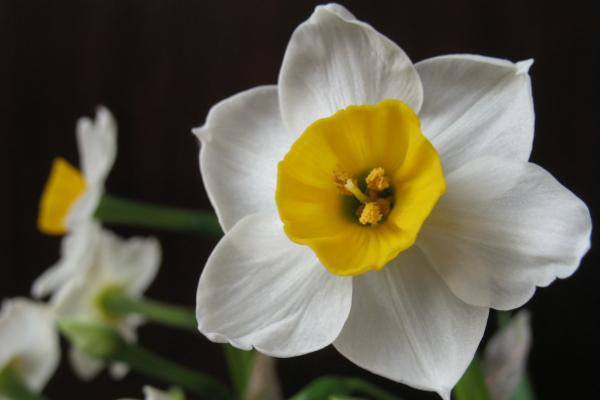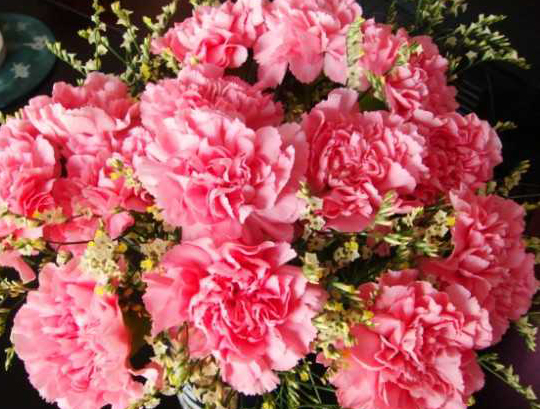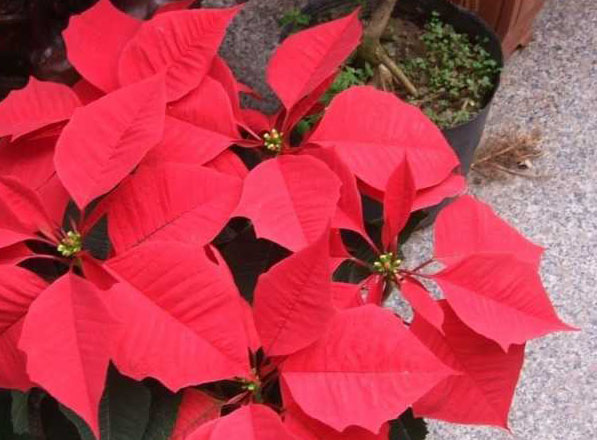What kind of growing environment is required for daffodils?
Daffodils like warm, humid climate, avoid hot and high temperature; like wet water, more hardy. Narcissus is a bulbous flower planted in autumn, which has the habit of growing in autumn and winter, flowering and storing nutrients in early spring, and dormant in summer. Flower bud differentiation was carried out at the growing point of the bulb during the dormant period.
1. Light. Narcissus is a short-day flower, which can develop normally as long as it has 10 hours of light every day. If the light is not enough, the leaves are easy to grow, and the flowering is few or not; if the light is too strong, it is also disadvantageous to its growth.
2. Temperature. Daffodils have different requirements for temperature in different growth periods. It is cool in the early stage, hardy in the middle stage and warm in the later stage. It is most suitable for bulb expansion when the air temperature is 20-24 degrees and the air relative humidity is 70% ~ 80%. The optimum temperature for flower bud differentiation is 17-20 degrees, and the air relative humidity is 80%. When the temperature exceeds 25 degrees, flower bud differentiation will be inhibited and flowering will be affected.
3. Moisture. Daffodils like water and dampness, and need more water in the period of vigorous growth and development. The demand for water is relatively reduced in the mature period.
4. Soil. When cultivated in open field, sandy loam with deep, loose, rich organic matter and strong water retention should be selected, and the soil acidity and alkalinity can grow well in ph5.0~7.5.

What is the language of daffodils?
Chinese daffodils: flower words are affectionate and miss you. It also symbolizes missing and reunion.
Western daffodils: flower words are looking forward to love, love you, purity.
Daffodil: the flower language is to relive love.
Mountain narcissus: the language of flowers is a good time and prosperity.
Autumn daffodils: the flower language is "youth without regrets".
The moral of daffodils
1. "Pure", or "Pure Love", is dedicated to women and praises their moral character.
2. "auspicious" is used for relatives, friends and their families. Good luck.
3. Daffodils bloom during the Spring Festival to symbolize reunion. So Narcissus means "yearning and reunion". Different moments have different meanings.
What if the leaves of daffodils are soft?
1. Reason
The leaves of daffodils become soft because of their overgrowth, and the crazy growth of plants leads to their small blossoms.
2. Prevention and control methods
Sunlight control method: ensure enough sunlight, put the daffodils outside or on the balcony in the sun, and then take the daffodils from the outside to the room at night, so that the leaves of the daffodils can grow and the inverted flowers will not appear.
Chemical control method: pour 2% salt water into the flowerpot to control the excessive growth of daffodils, and the flowering period of daffodils is longer; quantitative infusion of chemicals into the pot can better control the crazy growth of leaves. The height of the plant is about 15 cm.
The difference between daffodils and hyacinths
1. Distinguish from appearance
Narcissus: its leaves are flat and banded. The leaves are green with parallel veins and look very neat. In general, a daffodil has about 5 to 9 leaves on it. The flowers are white, the middle and the lowest part of the petals are yellow, and they look delicate and fresh. A flower has about six petals, which are roughly oval in shape. There is a fragrance when it blossoms.
Hyacinth: its leaves are very thick and green, with depressions on them. The flowers of hyacinths have flowering stems and inflorescences on the scape, each with about 10 to 20 florets, with a variety of colors. The common colors are blue, pink, yellow and so on. The bulbs of flowers look a lot like garlic.
2. Distinguish from the region
Narcissus: this is a kind of flower with a long history of planting in China. As early as the Tang Dynasty, China was introduced from Italy. With the passage of time, it gradually formed a kind of unique flower in our country. Nowadays, it is mostly distributed in the southeast coastal areas of China.
Hyacinth: it originated in Europe and is widely distributed in the Netherlands and near the Mediterranean coast and Asia minor, but with the popularity of people, they can now be found almost all over the world. And now the Netherlands is its main producing area, but also is named as the national flower.
3. The main values are different.
Narcissus: such a beautiful flower, the primary value of nature is to watch, it is said that it has the function of absorbing noise. In addition, Narcissus can also be used medicinally, can be used for heat-clearing and detoxification, anti-inflammation and detumescence, and is widely used.
Hyacinth: its flowers are beautiful and dignified, not only this, but also a variety of colors, so they are often used as decoration, whether it is a flower bed or home, are very suitable. In addition, this kind of flower is also often used as cut flowers, water culture and so on. It is said that the aroma of hyacinth flowers has a calming and calming effect, which can not only eliminate fatigue, but also calm the mood, so it is often used to extract and make aromatic oils.
Open field planting method of daffodils
1. Soak the cultivated land
Loosen the land from August to September, then soak the field with waterproofing and drain it for about 1-2 weeks. Subsequently, ploughing was carried out many times to improve fertility and reduce unnecessary diseases and insect pests so as to increase the air permeability of the soil.
2. Fertilizing and making beds
Using a large amount of chemical organic fertilizer as base fertilizer, the demand is 5000-1000 kg per mu, and it needs 3-year-old cultivation. The border surface should be regular and smooth, and the running water is smooth.
3. Bulb castration
In order to meet the need for more flowering, the bulb needs to be castrated on the same principle as peeling the buds of plants.
4. Disinfection treatment
Disinfect the ball with 40% formalin 100 times solution, need to soak the ball for about 5-10 minutes.
Daffodils like to grow in a warm and humid environment, and the breeding method is also very simple. General simple breeding method is hydroponic daffodil, after all, its growth requirements are not much, a basin of water can also let it survive and blossom to death. Flower friends in need quickly raise a pot and put it in the living room or study at home.
How to raise daffodils how to grow daffodils
In fact, raising daffodils is not much different from raising some other flowers and plants. It is usually a rough process of selecting species first, then cultivating them to take root and then sprouting, growing and then flowering. However, how to make the growth process more smooth is our focus today.
How to raise daffodils
The main contents are as follows: 1. We should pay attention to the three main points of shape, color and pressing feeling in the selection of balls. Look at the shape: high-quality Narcissus bulb, generally large, flat, hard, wide stripes of the longitudinal veins of the epidermis, tight media, bright skin color, broad and thick root disc, symmetrical bulbs beside the main bulb; look at the color: from the appearance, the corm is dark brown, the capsule is intact, the color is bright, there are no signs of decay and insect pests. Pressing: pressing is the main means to select and identify the number of daffodil arrows. You can use your thumb and index finger to hold the bulb and press it a little hard. The outline of the handle is columnar, elastic and solid, which is a flower arrow; the handle is soft, the outline is flat, and the elasticity is slightly less.
2. Choose the appropriate growth environment. Daffodils like sunshine and warmth, and require high humidity in the air, not very cold-resistant, and afraid of heat, and the vegetative growth period needs wet sandy soil without stagnant water. Narcissus is different from other perennial herbaceous flowers in that it begins to grow in autumn, blossoms in winter, stores nutrients in spring and dormancy in summer.
3. Hydroponic cultivation method or soil culture method should be selected correctly to cultivate narcissus. The water culture method is the shallow basin water immersion method. Put the Narcissus upright into the shallow basin of Narcissus after budding, and it is appropriate to submerge the bulb 1/3 with water. The bulb can be fixed with quartz sand and pebbles in the basin. During the day, the Narcissus basin should be placed in a sunny place and moved into the room at night. The water in the basin should be poured out to control the excessive growth of the leaves. Add fresh water the next morning, and be careful not to move the direction of the bulb. During the period of daffodil water culture, it is necessary to give sufficient light. It should be placed in the sunny place during the day and under the light at night, which can prevent the daffodil leaves from growing, while the daffodils leaves are short, wide and strong, the leaves are thick and green, the flowers are fragrant, and the water raises the daffodils, generally without fertilization. If there are conditions, apply some quick-acting phosphate fertilizer during flowering, the flowers can bloom better, as long as you master the conditions for the maintenance of daffodils, you can "bloom as you like". Otherwise, it will be delayed, or even the leaves will not bloom.
The soil cultivation method is seldom used in families, that is, the cultivation of daffodils is cultivated by the cultivation of most embellish flowers. In mid-late October, large bulbs were planted in small porous flowerpots with fertile sandy soil, half exposed, and some fine sand should be padded under the scales to facilitate drainage.
How to grow daffodils
1. Buy the daffodil seeds first and wash them clean.
2. Take out the hydroponic cover and put the daffodils in. the root is on the bottom of the head and on the top.
3. Take out the fish tank and fill it with water, and then cover the daffodils.
4. After putting it up, let's see if the water goes to the root. Before we get there, we continue to release water to the root, and then we don't release water. Can't go beyond the root. Then when this is over, we will take off the hydroponic jacket and put the colored stone in it. It's probably fine. Don't put too much.
Then you can drop a few drops of nutrient solution into it, but don't drop too much, or it will be bad.
Note: when the water is dirty, you must change the water. Don't wait for the completely yellowed one to change the water. If you have time, change the water every day. Generally, it will blossom in about 30 days.
Propagation methods of daffodils
1. Lateral bulb reproduction: this is the most commonly used method. The lateral ball is planted on both sides of the bulb, and only the base is connected with the mother ball, so it is easy to break away from the mother ball. It will be separated from the mother ball in autumn and planted separately, and a new ball will be produced the following year.
2. Lateral bud propagation: lateral buds are buds wrapped inside bulb bulbs. Only during bulb castration, lateral buds are separated from the mother along with the broken scales dug out, white buds are picked out, sown on the seedbed in autumn, and new balls are produced the following year.
3. Double-scale propagation: the bulb disk with two scales is used as propagation material, which is called double-scale propagation. The method is that the bulb is first placed at a low temperature 4C~10C for 4 to 8 weeks, then the bulb is cut small at room temperature, so that each piece has two scales, and the upper end of the scale is removed and left 2 cm as propagation material, and then the plastic bag is filled with 50% water-containing sapphire or 6% water-containing sand, the breeding material is put into the bag, the mouth of the bag is closed, and the small bulb can grow in the dark place in 20C~28C temperature after 2-3 months. The ball rate is 80% to 90%. This method can be carried out in four seasons, but it is better from April to September. The survival rate of the generated bulbs after transplanting can reach 80% to 100%.
4. Tissue culture: using MS medium, adding 30 grams of sucrose and 5 grams of activated carbon per liter, using bud tips as explants, or using stem disk 5X10 mm with double scales as explants, PH5~PH7, cultured in 25C, producing small protuberances 10 days after inoculation, small balls after 20 days, transferring to the medium containing NAA0.1 mg 1 / 2MS one month later, roots and leaves were produced after 6 weeks and 8 weeks, and the transplanting field could survive 100%.
What does daffodil symbolize?
Daffodils in the New year symbol-yearning, indicating reunion.
Daffodils symbolize the yearning for their loved ones. It has pink ice heart, delicate orchid fragrance and beautiful stems and leaves. At a time when the twilight days are cold and the flowers are dying, the ice muscle jade flowers are flowing with fragrant and elegant fragrance, which is refreshing.
The maintenance of daffodils is very picky, she has been adhering to the principle of reaping the melon, good pay has a good return. So the more careful we are in the process of planting, the better daffodils are likely to grow. at the same time, daffodils are a flower with a very good meaning in our country, and good planting is also very beneficial to the improvement of the family environment.
- Prev

How to raise potted carnations
Carnation (carnation) dianthuscaryophyllus nickname: carnation, lion head carnation, Dutch carnation application: for flower beds, potted and container seedlings, cut flower products. Seed weight: popular species, 5OO seeds / g
- Next

How to cultivate potted poinsettia
Poinsettia is also known as poinsettia, ivory, etc. Is a semi-evergreen shrub. The stem has white milk. Inflorescences terminal, bracts near inflorescences scarlet. The florescence is during the Christmas season in mid-and late-December. Potted poinsettia should be changed in early spring every year.
Related
- Fuxing push coffee new agricultural production and marketing class: lack of small-scale processing plants
- Jujube rice field leisure farm deep ploughing Yilan for five years to create a space for organic food and play
- Nongyu Farm-A trial of organic papaya for brave women with advanced technology
- Four points for attention in the prevention and control of diseases and insect pests of edible fungi
- How to add nutrient solution to Edible Fungi
- Is there any good way to control edible fungus mites?
- Open Inoculation Technology of Edible Fungi
- Is there any clever way to use fertilizer for edible fungus in winter?
- What agents are used to kill the pathogens of edible fungi in the mushroom shed?
- Rapid drying of Edible Fungi

